September 21st, 2010 · No Comments
The parks of London provide a natural respite from the busy, hectic, and stressful atmosphere of the city. Once in them, you are enveloped by a green tranquil, unable to hear the bustle of cars and people outside the parks’ confines. I have personally experienced this phenomenon at several parks, ranging from Regent’s park (where I ran for the first time since surgery! not a bad debut location), Hyde Park, and most others. This type of division between hustle-bustle and repose mirrors the separation of work and play that Fox often talks about.
However, there is also a clear division within the park of activities that mirrors this division of social and work life. There are areas for sitting contemplatively in very silly chairs, which you are supposedly required to pay for. There are areas for looking at quite nice fountains, sculptures, or gardens. Then there are designated areas for sports, with soccer nets and rugby… posts? Tennis courts seem a bit necessary to be fenced off for convenience’s sake. Several little cafés are sprinkled throughout the parks as well.
Regent’s park matches the above description. I’ve made several trips to this park to run, play a bit of ultimate, have a cup of coffee, or just stroll around and look at the great horticulture. However, all of these activities would occur in different locations in the actual park. This segments the activities, and consequently divides the people that enjoy different forms of recreation. Personally, it made me very uneasy. If I were to throw a disc in the wrong area, I risked getting publicly reprimanded (as classmates have experienced). Anyway – it would take quite a bit of time for me to analyze this division (and I really don’t have the experience or expertise to do so) but there has to be some sociological effect. If you have thoughts on this, just comment on this post.
However, not all parks match this model. St. Jame’s park, home of many venereal diseases during the restoration period, per Dennis’ description, is seemingly built for nothing but comfort and relaxing. There are nice little walks along the lake, a couple bridges, some out-of-place fowl, and many large grassy areas upon which you can sit. However, in a couple walks through the park, I never saw anyone playing catch, football, or any other sport in these large areas. Though it was suspiciously absent of proper monuments (at least, I didn’t see many), the website is careful to highlight the pelican feeding from 2:30-3, and the deck-chairs. Weird. More leisure activities. I should note that there is a quite disproportionately small playground for children. However, as a whole, this is not a built-for-fun park. It is a built-for-relaxing-park, and I think is such because of its close proximity to Buckingham Palace. Green Park, also bordering Buckingham Palace, mirrors this model of relaxation, rather than recreational, with a few monuments (such as the Canada memorial), and is a bit more open green spaces rather than pathways-and-lakes. To me, these two parks are just not okay. I envision parks as a place where you can run around, play whatever kind of games you want. Having fancy gardens in parks just seems to counteract this.
Hyde park, the last park I will discuss in this post, blends athletics and relaxation much like Regent’s. And, just like Regent’s, different activities are segmented. There are different areas for sitting in lawn chairs, areas for tennis, I’ve seen people playing soccer on some of the larger fields (quite far away from the chairs, mind you), and the notorious Speaker’s Corner, completely ostracized from any central location. I suspect that its location is completely intentional whatever authority governs the parks wanted to make sure the… colorful characters that frequent the corner would not pollute (in their mind) the rest of the park.
Well, the parks are divided not only from the city but often divided within themselves. What effect this has on the psyche of park attendees, I’m not sure. Though I love the idea of having large parks in cities, I don’t like this division. If you want to have fancy gardens, just don’t call the whole thing a park.

 That these two photos (both personal) came from the same park (Regent’s) makes little sense to me (though the picture from the right, in my opinion, should not even come from a park).
That these two photos (both personal) came from the same park (Regent’s) makes little sense to me (though the picture from the right, in my opinion, should not even come from a park).
Tags: 2010 ChristopherB
September 20th, 2010 · 1 Comment
I used to think that William Wordsworth was kind of a sap, always going on about daisies in a field and all that in his poetry, but since arriving in London, I’ve come to respect his stance a lot more. I still think that Wordsworth is a bit melodramatic, but I understand his need to remember images from nature. I grew up in rural Connecticut, so I’m used to seeing cows, fields, and woods all on my two-minute drive to the center of town. Before this program, I had not spent more than three consecutive days in a city, and I can honestly say that the parks have kept me sane. London is a wonderfully dynamic city, but it’s also exhausting, and I think that the parks here are an absolute necessity for the people who live here.
London, like any major city, is loud, chaotic, fast-paced, and extremely crowded. Walking down Tottenham Court Road is an exercise in agility. Weaving through people all of the time, especially tourists who stop short to take photographs or consult maps, can become extremely frustrating. But inside of the parks, the bustle of the city seems much farther away. In Queen Mary’s Garden at Regent’s Park today, I was almost able to forget that Marylebone Road ran just outside of the gates. It’s quiet, and you can actually hear the sounds of nature. Although some parks undeniably attract more tourists than others, I saw people just laying on the grass sleeping, reading, doing absolutely nothing at all, in all of the parks that I visited. I think that people are just so relieved to be out of the insanity that is London’s streets that they can’t resist the opportunity to sit down and enjoy a quiet moment.
This is reflected in the development of the parks, as well. Regent’s Park and St. James Park were both made into hunting grounds by King Henry VIII, but they’ve become beautiful, public green spaces. Hyde Park and Kensington Gardens really were formed due to necessity; Queen Victoria decided that the public could really use a park to combat the crowded, polluted conditions of a newly industrialized London in the nineteenth century. Wordsworth fell at the beginning of this time–in his day, London was just beginning to become an industrial power, and we can be fairly certain that his description of the city in his poem “Composed Upon Westminster Bridge” were not completely accurate. Wordsworth sought out beauty in nature because he was suffocated by conditions in the city.
Yes, some of the gardens seem a bit contrived (the bridge at St. James Park just happens to offer beautiful, leafy views of both Buckingham Palace and Whitehall), but the English do love gardening. And today in Regent’s Park I saw people ambling slowly through the very well-manicured rose gardens, literally stopping to smell the flowers. Couples were cozied up on benches, people were reading under weeping willow trees, and one gentleman was just conked out in the sun. As I walked down the avenue, I noticed people sunbathing and playing a football match, also a common sight in Hyde Park and Kensington Gardens. No one, regardless of whether or not they were tourists, was in a hurry, and that’s exactly why the parks here in London are so important. People just need an escape from the city for a bit.
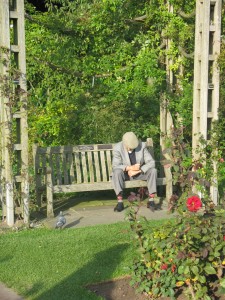
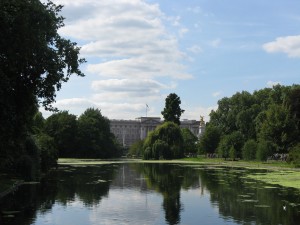
Tags: 2010 Holly
September 20th, 2010 · 1 Comment
This afternoon myself and a friend visited Regent’s Park to have a bit of footy in the sunlight. The day was beautiful, and the park was breathtaking. Being my first visit to Regent’s Park, I can honestly say I could have spent days there. The major difference between Regent’s Parl from the other park that I have spent the most time in, St. James Park, was the awesome, gigantic field space used for sporting activites or “ball games”. We spent time in both the large, sport dominated field area as well as the walking route among the gardens and fountains of Regent’s Park (I would have several lovely pictures for you all of our leisurely day, but sadly I left my camera in the hotel upon departure). In comparing Regent’s Park to St. James Park there are a few key differences.

(Regent's Park)
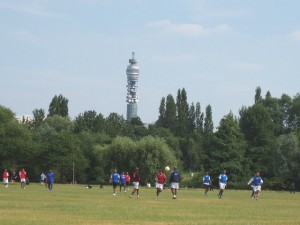
(Sporting Area of Regent's Park)
Regent’s is divided into two sections, the “ball games” field section and the walking route (which has a few little subsections). St. James only has the walking route. Both are beautiful, St. James seemed a little bit more open in the strolling section, and had a little more to offer visually in terms of natural elements (it’s on that fantastic lake and has all those birds running around, it’s hard to beat the pelicans). It seemed like perhaps more manmade work had been done in Regent’s however, the section that we strolled through had several beautiful fountains and well placed gardens, giving it a very tranquil and calm feeling (not as many people either). I could go on for days about how beautiful and elegant these parks were, but I want to discuss what their purpose actually is in British society.
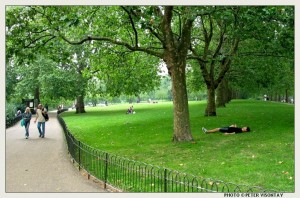
(St. James Park)
The Brits put a lot of pride in three things: museums, churches, and PARKS. These parks all have had one or more notorious architects working on their designs and perfecting them over centuries. They are signature landmarks of the UK, world famous Brits and royalty have worked through them over hundreds of years. Why? Like I said in my blog about the purpose of pubs in British society, it seems like when the Brits aren’t living the hustle and bustle lifestyle of London, in packed tube cars and crowded streets, they like to take a minute to value their time with others and the so called “simple things” rather than spend their time playing watching television or on their computers, like Americans. The Brits are generally doing one of the following things during their visit to the park: walking their dog, chatting with a friend, having a picnic, kicking around the old football, or just having a stroll. All simple, leisurely activities that you don’t need to pay a cover charge for. These parks have so much money and effort poured into them because most of the population of the UK treat them as a national treasure and use them so much. They are a significant part of the history of England. Cheers.
Photos courtesy of: londonrelocationservices.com, yourlocalweb.co.uk, earth-photography.com
Tags: 2010 Benjamin
September 20th, 2010 · 1 Comment
Probably because I get a little claustrophobic in cities, my visits to parks have definitely been some of the highlights of my time in London. I enjoyed the sense of space, the people watching, and the sheer beauty of much of the landscaping. However, I did pick up on a certain artificiality throughout London’s Green space.
First of all, the lakes, which are in most cases absolutely beautiful, provide variety in scenery, are home to so many (sometimes exotic looking) species of birds, and they also provide a fun and novel activity for those who choose to rent paddle boats. In St. James Park, the bridge in the middle of the long, central pond is carefully positioned so that visitors can view Buckingham Palace in one direction and the London Eye in the other. The sheer overcrowding of the birds (and their excrement), especially in St. James Park makes me slightly uncomfortable. It seems as though London attempts to make up for the obvious lack of wildlife in the rest of its urban environment by crowding high quantities into small, carefully designated areas. In the “wetlands” area in Regent’s Park, I noticed a rat basking by the water’s edge along side the usual variety of birds. It goes to show I think, that it is impossible to completely keep out the less picturesque aspects of the city.
The gardens that I visited, and especially those in Regents Park were absolutely beautiful. Signs pointed out over twenty different species of roses, and everyone who I saw seemed to walk through slowly. However, when I reflected on how often the grass must be cut, to keep it that short and the precise patterns in which the plants were arranged, the set up seemed more like a human achievement than natural beauty. Hours of work daily clearly go in to maintaining the gardens.
Playgrounds in London’s parks also seemed equally controlled . Every playground that I have seen so far is fenced in, and most do not allow people in unless they have children with them. These playgrounds, which are often large and colorful, must be a welcome refuge to parents who live in the city and are accustomed to having to constantly watch their children in all public places. They definitely reinforce my impression that London makes it a priority to provide leisure space, but only carefully controlled leisure space.
That said, anyone is free to walk into the vast majority of London’s parks. People from all walks of life go there, though it is not a place to interact with strangers. It is socially acceptable to be alone, with large groups of friends or family, or anything in between. In many there is enough space to talk loudly, but I was able to find somewhere quiet in Regents Park to sit and read a book. Maybe all of the control allows for a greater sense of freedom.
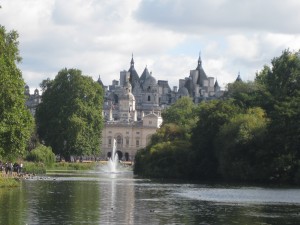
St. James Park (Personal Photo)

Hyde Park (personal photo)
Tags: 2010 Emily · Uncategorized
September 20th, 2010 · 2 Comments

One of the things that make London distinct from almost any other city I have visited is the amount or room dedicated to parks. Walk a few blocks and you are bound to encounter a vast expanse of greenery, or see a small garden area with some benches and statues. While a few of these parks (particularly Greenwich) are more organic in nature, and feel just like large open space areas to roam, most of these parks feel planned out to the last blade of grass. Hyde Park boasts a picturesque lake(The Serpentine) with neatly laid out park benches around it. The grass in St. James’ Park is always perfectly cut, and the main bridge in the middle of the park looks like it was installed yesterday. The shrubbery and gardens in Regent’s Park remind one of Versailles. All of these places seem sculpted to be as visually pleasing as possible.

The trend seems to be that the more central the park to the center of the city (Particularly St. James’ and Regent’s Parks), the more likely the park is to be perfectly planned and sculpted. There are several possible reasons for this. One, it could simply be that the city anticipates more people going through these areas, so they want them to look the nicest. Another possibility is that they expect these areas to get the most tourists, and the parks exist more for image than actual recreation (a point I’ll get to a little later). Finally, it could be that these areas are closest to the monarchy, and they have more of a say over these parks. Whatever the reason, there is no doubt that the parks in London are far more mapped out and planned than a majority of parks in American cities.
The question now is: is such planning a good thing? I personally see it as more of a mixed bag. The parks here are much more visually stunning than most I have seen elsewhere. The feel of the parks harkens back to the original intention of the parks: to make the poor and unprivileged feel like they had access to the wealth of the monarchy. You really feel like you are walking through the Queen’s personal gardens when you take a stroll through Regent’s Park. However, this meticulous planning takes away a little bit of personality from the parks. I get no sense of true, organic, nature while walking through St. James because everything feels so mapped out. In addition, the regal nature of the parks appears to hinder a lot of activity within the parks. Most people seem to simply be walking slowly through these areas, or sitting on a park bench. There are rarely any cyclists, joggers, Frisbee players, kids running around, or anyone playing games. This inactivity is partially because a lot of games are banned in certain areas of the parks, but I think it is also due to the intimidating nature of such perfectly sculpted areas. After walking through the immaculately-trimmed hedges of Regent’s, or after crossing the bridge in St. James’ with the marvelous view of Buckingham Palace, it is hard to think: “Gee, this is the perfect place to run around and throw a Frisbee.” As a result of such overplanning, the parks lose this energy, and also a little bit of quirk.

I love the fact that London has so much green space, and that the city takes such good care of these areas. However, the parks are so meticulously sculpted that the areas seem almost unnatural. The lack of physical activity makes the area feel calm, but it also takes something away from its overall personality. I have enjoyed my time walking through London’s parks, but one wonders whether a bit less planning would make these areas more fun and inviting to the public.
Tags: 2010 Andrew
September 19th, 2010 · 1 Comment
I think that one of my favorite things about London is its parks. I have mentioned before in some of my other posts that I don’t think I could ever live in a big city – the crowds and the hurry and the size just stress me out too much. I’ve found that parks are one of the few places where you can have space to walk down a path in a straight line without having to dodge and weave and bump into people and say “sorry.” I’ve found that parks are also a place where you are pretty much guaranteed a place to sit, and you don’t necessarily have to be within ten feet of another person either. It’s lovely that London thought to create places where there is enough space for large amounts of people to be, unlike on the tube or on the streets, where there just simply isn’t. The peace is more beautiful to me than all the trees and flowers and landscaping, although that is pretty too, and a nice break from the architectural chaos of London. I think you really could lose yourself and forget about the city for awhile in parks if you wanted to. When I visited Hyde Park*, I took the following two pictures of the lake:
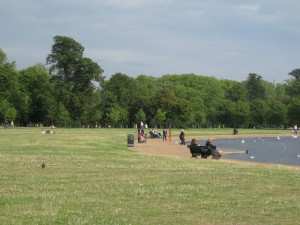
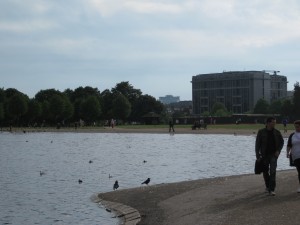
Oh right, the city. There it is. These two pictures seem a bit incongruous; you could probably lie, and tell people that they are different lakes in different places, and they might believe you.
It seems that parks have several different uses for people in London. The first park I visited was St. James Park, and there I joined many other people picnicking on their lunch break. This seems much more enjoyable than inhaling a sandwich on the tube, and if I ever were to work in London, I would want a job where I could eat lunch in the park. The other side of the bridge at St. James however, toward Buckingham Palace, is much more touristy. I was alerted to this by the presence of an ice cream stand, and chairs that you could pay to sit in. I don’t see this as a problem though, as tourists, I am sure, also need a break from the city. Other uses I have seen for parks include
dog walking
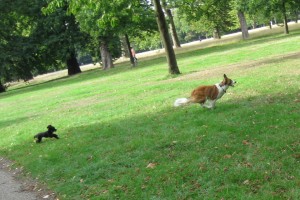
dates

studying

or just being alone and doing whatever you want.

A last really important use for parks, I think, is creating a safe space for children. Professor Qualls brought up this point on the Bloomsbury walking tour, when he took us past the Coram playground, and explained that it was fenced off because you were not allowed in unless you had a child. I saw this again at the Princess Diana Memorial Playground in Hyde Park. It was fenced, plus there was a guard at the door checking people. I witnessed a man come up to the guard and ask if he could see if his wife was in there with his son. The guard told him he could not go in. While this man probably was the father of a child, it is also possible that he could have been a child snatcher, and I personally am a fan of this playground rule that protects children against them. I don’t think we have this in America, or at least I’ve never seen it. At the playground near my house, high school kids smoke pot after school.
While I am excited to move to Norwich and escape the city more or less permanently, when I do return to London, parks will be on my list of places to revisit.
*Note: I am not exactly sure where Kensington Gardens ends and Hyde Park begins. This lake could very well technically be in Kensington Gardens. My apologies to Kensington Gardens if this is the case.
**Note also: all photos in this post are mine. Sorry if you think I’m creepy for taking pictures of random people. It was all in the spirit of academia.
Tags: 2010 Kaitlin
September 15th, 2009 · No Comments
-
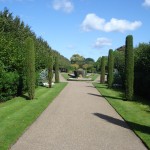
-
Regents Park
-
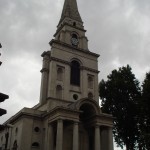
-
Christ’s Church
-
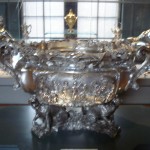
-
The Silver Exhibit in the V&A
-

-
Having a Good Time at the Fitzroy
Like many of my classmates I decided it would be worthwhile to summarize all of my discoveries this month in London. During this post I will focus on six main themes found within London: Parks, Churches, Pubs, Other Religious Institutions, Theatre and Museums.
Parks
Each park that I visited had its own distinct characteristics that separated it from any other. Green Park was the first I visited and after perusing a few others, I realized there was nothing that exciting about it. Located right across from Buckingham Palace, Green Park certainly provides a good place to go and take a break from the busy atmosphere of the area. Besides this however there is not much going on and I would recommend that potential park goers walk the extra distance over to St. James Park.
In addition to the large number of waterfowl heckling people for food which offers consistent entertainment St. James offers some picturesque flower beds throughout and various monuments along the way. It has the relaxing atmosphere of Green Park with a bit more excitement sprinkled in.
Regents Park offers a completely different feel from Green or St. James. Located in a separate area of London, Regents Park has a history of being used by a higher end crowd. I could tell this immediately from the feel of the park. The decorative shrubbery and elegant architecture throughout gave me a feeling that Regents is not as well used as other parks.
Since I was one of the members of the Parks group that gave a walking tour of Hyde Park and Kensington Gardens I could go into a lot more detail about these two green spaces but I will choose not to in an effort to be concise. In summary Hyde Park is the largest green space in London and is often used for larger events such as concerts, festivals etc. It also contains a large number of monuments throughout including the 7/7 memorial and the Diana Memorial Fountain. Kensington Gardens is home to a variety of key monuments but is not as well trodden as Hyde. Overall it makes for a quieter atmosphere, more conducive fo reading or “snogging”.
Regents Park were my two favorite green spaces in London. Regents, is both beautiful, and extremely large and I continually felt the need to go back and explore. Kensington Gardens appealed to me in that it was quainter than Hyde Park but contained a like amount of history and monuments throughout. Although I would be content spending a length of time in any London green space Regents and Kensington would be my top choices.
Theatre
Overall I enjoyed going to the theatre on so many occasions. What better place to do so than in London after all? Here I will discuss my favorite performances and theatre venues.
All in all I enjoyed all but two of the performances we saw. The two Shakespeare productions at The Globe Theatre were fantastic. Although I did not particularly enjoy reading Troilus and Cressida it made a huge difference to be there so close to the actors. The fantastic drum chorus at the end really sealed the deal. As You Like It was probably my favorite show I saw here in London. Although it is one of Shakespeare’s simpler plays the actors really made it jump off the page. Being down it the pit was fantastic because of all the ad-libbing and constant interaction with the crowd. I even felt traces of Touchstone’s saliva on my arm at one point.
The other Shakespeare performance I saw, All’s Well That Ends Well, was lackluster. Although the Olivier was my favorite performing venue (this is what an auditorium style theatre should be like…why can’t Dickinson have something like this?) the play itself was odd and ended on an abrupt and odd note.
The other play we saw at the National Theatre, The Pitmen Painters, was fantastic. Although I was dozing a bit because of the Benadryl I took right before the show, the actors kept my attention and I appreciated that the play was based off of a true story.
Easily the oddest play we saw was Arcadia. An extremely intelligent performance the play juxtaposed two different periods in time and created a singular storyline in which the plot was based. Overall it was an entertaining performance that made me think early and often.
Finally there was Blood Brothers. The lone musical I saw produced feelings of disbelief, anguish and held back laughter. The ridiculous 80’s sound track and creepy narrator just didn’t do it for me. I think it’s safe to say that I was not the only one from Humanities 309 who was a bit surprised to see just about everyone in the audience give it a standing ovation.
I had a very positive experience with the theatre here. I would go back to the globe again and again. I loved being that close to the action. I would also enjoy seeing another show in the Olivier. There really is so much to choose from here. It’s simply a matter of figuring out your tastes and saving your money so you can see a lot of performances.
Churches
From Westminster Abbey to St. Paul’s Cathedral we saw most of the major churches/cathedrals during our month in London. St. Paul’s was easily my favorite. From the fantastic crypt to the hundreds of stairs up to the tower it had so much to offer in the way of history and mystique. Westminster Abbey fascinated me primarily because of all the literary figures that had been buried inside as well as the room that was dedicated to “The Order of the Bath”. Other churches that I really enjoyed taking a look at were: “St. Martin in the Fields” which sits just outside Trafalgar Square and Nicholas Hawkesmoore’s “Christ’s Church” which is located in very close proximity to Brick Lane.
Other Religious Institutions
Overall the Sikh Gurdwara was my favorite place that we visited. I appreciated the simplicity of the religious doctrine as well as the conviction and honesty with which our tour guide, Mr. Singh spoke. The morning was capped off with a fantastic sit down meal together in which everyone was served the same food and drink.
I had different feelings about the Hindu Mandir. It was clear to me from the very beginning that the Hindu religion is not nearly as modest as Sikhism nor are they trying to be. From the extremely decorative prayer room, to the museum located right in the center of the Mandir I never felt particularly comfortable inside.
The only religious institution I wish we had gotten a chance to visit is a Mosque. I had been to one many years ago but I did not remember a whole lot from my experience. I wonder how much more lively the East End, and all parts of London would be if Ramadan were not taking place during our time here.
Museums
I could go on and on about museums so I will attempt to stay as concise as possible.
The British Museum was massive, convenient since it was so close to the Arran House but a little one dimensional at times. One of my favorite exhibits at the British Museum was a special exhibit on Living and Dying that drew information from all different time periods and cultures.
The National Gallery was fantastic. Although I have a hard time appreciating some visual art the gallery kept my attention for a number of hours. Seeing so many famous works of art was phenomenal.
The Tate Modern was my least favorite museum here. Although I am trying I have a hard time understanding modern art. After about 45 minutes in this museum it ended up being too much for me.
The Cabinet War Rooms/Churchill Museum were two of my favorites. The realization that I was standing in one of the most important places in World War II history was unbelievable. The War Rooms felt so authentic. I really felt as though I had been taken back in time to the 1940’s while inside.
The Victoria and Albert was easily my favorite museum in London. There was so much variety inside and so much to see. I could have easily spent a few days inside. Two of my favorite exhibits were the silver and jewelry exhibits. I’m not sure what this says about me as a person but I found it unbelievable that individuals could even own such treasures. I also enjoyed the laid back atmosphere of the V&A staff. At most of the other museums I visited I felt like I was doing them a disservice simply by being there. Although I understand that taking pictures of an object in a museum doesn’t do it justice I like to be able to have the option of doing so.
The Sir John Soane museum interested me but it wasn’t really my cup of tea in the end. It also had a stuffy atmosphere to it that I didn’t really appreciate.
One thing I can draw from my experience at museums here is that each and every one has something that distinguishes it. With so many museums I thought that it would be impossible to avoid some overlap but I never really felt that. Cheers to London and its museums.
Pubs
Finally we have pubs. What would London be without it’s public houses? In some cases pubs are the true museums of London, designating what an area was like in the past and what type of clientele it attracted. During my month here I had a chance to visit a few pubs and get a general sense of what some possible differences could be. It is clear to me that each pub brings something different and unique to the table. The Marlborough Arms was convenient being so close to the Arran House and was a great place to enjoy a pint over a meal with friends. The Court was conducive to socializing in a different way. The music was louder, the people louder and the drinks cheaper. Other places I visited offered other things that made them stand out as well. One thing that i’ve learned about pubs is that it’s hard for one to please everyone. Since everyone has different tastes and desires when it comes to pubs you are better off going to one with a small cohesive group.
To conclude this novel I would just like to say that I think we saw a lot of different faces of London this month. I realize there is much more to see here but between walking tours throughout the city, trips to major monuments and museums and individual exploration I have learned a ton about London, it’s history and where it is going. I look forward to more London explorations in the future but for now, ON TO NORWICH!
Tags: Churches and Cathedrals · Henry · Pubs · Theatre
September 14th, 2009 · No Comments
-
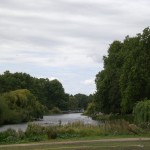
-
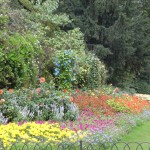
There’s nothing I love more than to be outside on a beautiful day. Growing up on the James River has allowed me to venture down for a “nature walk” whenever I’m home. I’ve been spoiled in that sense. So coming to London, a city full of parks seemed like a happy medium to me. I could participate in the big city scene and still enjoy my beloved green spaces. However, some of the parks have been ‘disappointing’ in that fact that they are so unnatural. What I mean by that is the exact planning and placement of walkways, restaurants, water features, ect. Sure, it’s a great place to exercise and push a pram along a scenic pathway (complete with perfectly manicured lawns!), but it’s not what I am looking for in my ideal park. I can appreciate the effort and money the city spends on these places. It’s a great place to take a break from the hustle and bustle of London and sit on a wooden bench to read your paper. But I find it incredibly strange that people are almost discouraged from sitting on the grass. Instead, deckchairs are available for hire from April to September. Another thing that really bothers me is the rule against ball games. The parks are great place for a pick-up 5 aside football (soccer) match… oh wait, you can’t play ball in most of these places. Why? I’m the kind of person who goes to open green spaces to relax. When I go to a park I want to be able to run free, lounge on the grass, play games, read and generally cut loose. I feel like I can’t do that here. I’m directing most of this rant towards St. James’s Park and Regent’s Park. Great flowers, too many rules.
I participated in the “Parks” tour group last Thursday and I absolutely loved Hyde Park. This 350-acre space in the heart of London still has most of the aspects I just discussed, but it has another side. In parts of this former royal hunting ground the grass uncut and long, the people walk off the path and you can even go swimming in the Lido. Maybe it’s just the sheer size of the grounds, but this park just “feels right” to me; this is how a park should be. I also noticed the large variety of wildlife at Hyde Park. Besides the normal flocks of pigeons, there were also surprising amounts of waterfowl living in the Long Water. The variety of activities was also impressive. One can do anything form tennis to horseback riding in this park! I hope I can go back for a little bit tomorrow after lunch and explore a bit more. Although I have some problems with a few of the Royal Parks, I cannot deny that they are a wonderful addition to the city. I am looking forward to the open air of Norwich… at least I can play some football there.
Tags: Grace
September 14th, 2009 · No Comments
I love being outdoors. There aren’t many experiences in this life that beat lying out in the grass with friends eating, drinking, snogging (sorry, it had to be said). The abundance of green space in London is one of the city’s best features. About 25% of London’s geography is comprised of parks, meaning wherever I happen to find myself wandering aimlessly through the city, I always run into a park, large or small, without fail.
The reason why this makes me so happy is because I am from suburban Harrisburg, PA, where parks are in short supply. The few that we do have are in poor condition, as park upkeep is quite low on the municipal spending bill; there are bigger fish to fry, like violent crime and sub par education. The one park I do frequent, Veterans Park, is always crowded, lacking in shade, and overall not particularly pleasant. My friends and I arrive, play some volleyball or ultimate frisbee, and get the heck out because no one has any desire to stick around.
Then I come to London and see spaces like St. James Park, where me and four others spent a few hours doing my favorite thing, lounging. Comically, we were approached by a man wearing coin box demanding payment for the use of the public chairs. In an act of civil disobedience that Dr. King or Mr. Gandhi would be proud of, we elected to sit on the grass. Regent’s Park is enormous, reminiscent of Central Park back in the states. Its open green pastures and winding pathways make it the perfect locale for a romantic walk or a morning run. The smaller parks are nice as well, secluded little getaways from the hustle and bustle.

St. James's Park from http://www.freefoto.com/images/31/06/31_06_6---St-James-s-Park--London_web.jpg

Regent's Park from http://www.londonphoto.me.uk/image/regents%20park.jpg
Now that our time in London is waning, I regret that I haven’t spent more time in parks. I was, of course, too busy blogging.
Tags: Andrew B
Since I am beginning to feel the crush of pressure to visit all the required museums while in London, I spent an afternoon in the Cabinet War Rooms/Winston Churchill Museum. In truth, I was not particularly moved by either. I think I lack a lot of the personal feeling involved in seeing such an important aspect of British history simply because I am not British. Churchill as a national icon means much less to me, an American, than it might for my English counterpart. Still, I most enjoyed listening to portions of Churchill’s speeches and writing down bits that inspired me. I also was interested in learning how he constructed his speeches, and found it endearing that he used notes only after he “dried up” at an important event. In the Cabinet War Rooms, I was struck most by learning that the lights in one of the most important rooms were literally never shut off for six years because of the war. I also felt badly for the people who worked such long, tedious hours in the bunker without much sunlight or rest. However, it’s also somewhat moving that these women and men cared so much for their country that they were willing to put forth so much time and effort, and I wonder if I would do the same for my own country.
After the museums, I stumbled upon St. James Park and decided to wander through. In doing so, I ended up in front of Buckingham Palace leaning on a wall, and it was there that I first truly FELT that I am in London. I was standing in the midst of a series of tour groups, many of which were not speaking English. I looked down upon the water moving, people walking alongside, a field with people sitting and relaxing, and a little coffee shop, all of which were surrounded by trees. Out of the trees rose the London Eye and the very top of Big Ben. It was the most picturesque view I’ve encountered thus far, and I don’t think that I’ll be forgetting it anytime soon. To me, it really captured the essence of London as I currently see it: a vital place with small tranquil spaces mixed throughout, the importance of tourism, national pride surrounding the royal family, history mixed with the present, and an ability to feel at home even for those not native to London. I wasn’t able to take a photograph because my camera is broken, but I would definitely be interested in seeing the places that have most inspired everybody else in their travels in the past two weeks.
Tags: Amy

 That these two photos (both personal) came from the same park (Regent’s) makes little sense to me (though the picture from the right, in my opinion, should not even come from a park).
That these two photos (both personal) came from the same park (Regent’s) makes little sense to me (though the picture from the right, in my opinion, should not even come from a park).























